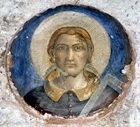

Cola Petruccioli, who was born in Orvieto, is first documented in 1357. In 1372-8, he was a young apprentice working for Ugolino di Prete Ilario in the choir of the Duomo of his native city. This period of apprenticeship probably ended at about the time of his earliest surviving signed fresco (1380) in the crypt of the Duomo (see below). He was also documented in 1380, with Francesco di Antonio and Andrea di Giovanni, in relation to the frescoes of a fictive choir in the tribune of the Duomo (see below).
Cola Petruccioli seems to have moved to Perugia soon after: his son Policleto di Cola affirmed (in a document supporting his own application for citizenship of Perugia in 1408) that Cola Petruccioli had lived there for some twenty years by the time that he died in 1401.
Orvieto
Crucifixion (1380)
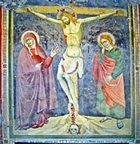
Fictive choir (1380)
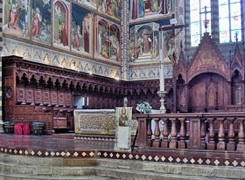
Cola Petruccioli, Francesco di Antonio and Andrea di Giovanni, are documented in 1380 in relation to the frescoes of a fictive choir in the tribune of the Duomo. These frescoes, which depicted the canons seated in choir stalls, were obscured when real choir stalls were moved her from the nave in 1536, and only the upper part of them is now visible.
Fresco fragments (ca. 1380)
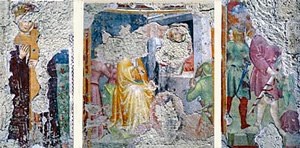
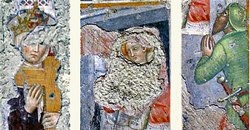
Details from the frescoes above
The 1st chapel on the left of the Duomo contains some lovely fresco fragments (14th century) that are attributed to Cola Petruccioli. The faces of St Helena (to the left) and the Virgin are particularly fine.
Annunciation (ca. 1380)
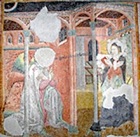
Assisi
Two documents dated 1394 record that Cola Petruccioli painted a number of coats of arms on public buildings in Assisi.
[A fresco (14th century) by Cola Petruccioli [subject ???] has been detached from the brick shrine above the portal of the the Oratorio di San Rufinuccio. Where is it now ??]
Madonna and Child with saints (ca. 1394)
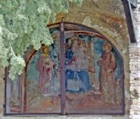
Foligno
Fresco fragments (late 14th century)
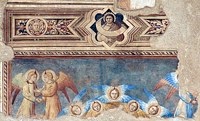
These surviving fresco fragments (20-2) in San Domenico, which are attributed to Cola Petruccioli, depicted:
-
✴the Assumption of the Virgin, with a prophet above (the surviving fragment of which is illustrated here);
-
✴the Presentation at the Temple (or meeting at the Golden Gate); and
-
✴the Madonna and Child with two saints (perhaps SS Catherine of Alexandria and Dominic).
Narni
Panels (1390)
Two documented panels in Sant’ Agostino, which depicted SS Fabian and Roch, were signed "Cola de orto pinxit MCCCLXXXX" (Cola Petruccioli painted this in 1390). They no longer survived there by the time that Giovanni Eroli described the church in his “Descrizione delle Chiese di Narni e Suoi Dintorni” (1898).
Perugia
Frescoes of Palazzo Stocchi-Isidori (ca. 1390 ?)
The frescoes in a room on the first floor of Palazzo Stocchi-Isidori were documented in 1871, when the then owner, Francesco Bassardini, informed the Mayor of Perugia that he wished to have them detached and sold to the city. Nothing happened until 1889, when the city commissioned an assessment of the works from three experts:
-
✴Luigi Carattoli, Director of the Accademia di Belle Arti;
-
✴Francesco Moretti, Director of the Galleria Civica; and
-
✴the artist and art restorer, Matteo Tassi.
This investigation did not lead to a purchase offer from the city, and most of the frescoes were detached and sold through intermediaries to the Szépművészeti Múzeum, Budapest in 1894.
There are two main hypotheses as to the date and attribution of the frescoes:
-
✴The frescoes have generally been dated to ca. 1380 on stylistic grounds and attributed to Cola Petruccioli. This implies that they were commissioned by Francesco di Berardo della Corgna.
-
✴However, Francesco Federico Mancini (referenced in the page on the palace) suggested that they were more probably painted shortly after 1416, when the nobles of Perugia were able to return to Perugia after a period of almost continuous exile that had begun in 1378. He therefore deduced that Corniolo della Corgna must have commissioned them from Policleto di Cola, the son of Cola Petruccioli and the inheritor of his workshop.
More recently, Corrado Fratini (referenced in the page on the palace) has argued that the frescoes in Palazzo Stocchi-Isidori owe nothing to a number of influential works executed in the region by leading artists in the early 15th century (such as, for example, the frescoes (1411-12) by Gentile da Fabriano and his associates in Palazzo Trinci, Foligno and the panel (ca. 1410) by the same artist in San Domenico, Perugia). He therefore favours the earlier dating and the attribution to Cola Petruccioli. He suggests that the work could have been commissioned in 1389-93, when it was the turn of the “popolo grasso” (the enemies of the nobles) to face exile.
Annunciation on a side wall
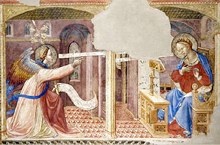
This fresco from the wall, which was transferred onto canvas before its transfer to Budapest in 1894, has recently been restored. It is set in a Gothic interior, in which a kneeling angel brings the message to Mary as she sits in front of a lectern. Unfortunately, the part of the composition, in which a dove representing the Holy Spirit would have been depicted, has been lost.
Virtues and Vices
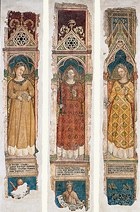
-
✴The allegory of the “Sapientia Domini” (Wisdom of God), which seems to have been the most important, was probably sited directly above the Annunciation (above).
-
✴The three Virtues illustrated here, which are among the best-preserved, depict (from the left): Fortitude; Justice; and the Active Life.
-
✴The other identifiable Virtues comprise: Faith; Hope; Charity; Love; Prudence; Temperance; and the Contemplative Life.
-
✴The two identifiable Vices are: Prodigality; and Avarice.
Labours of Hercules
The surviving fragments of this cycles, which were discovered in situ on the walls in 1993, were apparently covered by plaster and thus undetected in 1889-94. They have recently been restored.
Frescoes in San Domenico (ca. 1400)
The following frescoes in San Domenico are attributed to Cola Petruccioli:
Frescoes in the Apse
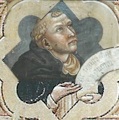
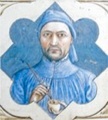
St Thomas Aquinas (?) Self-portrait (?)
The surviving fresco fragments on the left wall were probably part of a Marian cycle that covered all the walls of the apse. The survivals include the lower part of what seems to have been an Annunciation and a frieze below it that contains the two details illustrated above. [These fragments had been removed at the time of my visit in 2013.]
Martyrdom of SS Peter Martyr (1396)
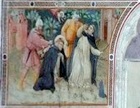
Fresco Fragment (1398)
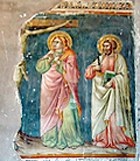
Spello
Diptych (1391)
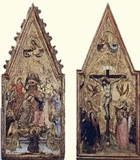
-
✴the Crucifixion with:
-
•the Virgin and SS John the Baptist and Mary Magdalene on the left;
-
•SS John the Evangelist, Nicholas of Bari and Catherine of Alexandria on the right; and
-
•the Archangel Gabriel above; and
-
✴the Coronation of the Virgin with musical angels, and the Virgin Annunciate above.
Agony in the Garden (ca. 1391)
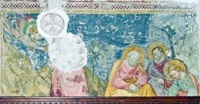
This damaged fresco in the apse of Santa Maria Magggiore, which is signed by Cola Petruccioli and, can be seen on the left of the apse, behind the choir stalls. It was probably originally part of a Christological cycle. [A fragment from it showing the head of Christ is now in the Cappella dei Canonici (behind the Cappella del Sacramento off the left transept)].
Frescoes (1393)
The Commune commissioned Cola Petruccioli to execute an important series of frescoes in San Claudio. They depict:
-
✴Christ in a mandorla supported by four angels, in the apse;
-
✴the Madonna and Child enthroned with SS Claudius and Matthew, James and John the Baptist below it, with the date inscribed below the figure of St Claudius;
-
✴the figures of the Annunciation in tondi in the spandrels below;
-
✴twelve frescoes in rectangles above the arches of the nave, each of which represented one of the confraternities of Spello, of which only five survive:
-
•San Rufino;
-
•Santa Maria Maggiore;
-
•Santa Croce;
-
•Sant’ Andrea; and
-
•Santa Maria di Vallegloria;
-
while seven (San Severino; Santo Stefano; San Sisto; San Martino; Sant’ Angelo; Santa Maria di Prato; and San Lorenzo) have been destroyed; and
-
✴St Claudius, in a tondo on the pilaster to the left of the apse, which was heavily restored in the 16th century.
